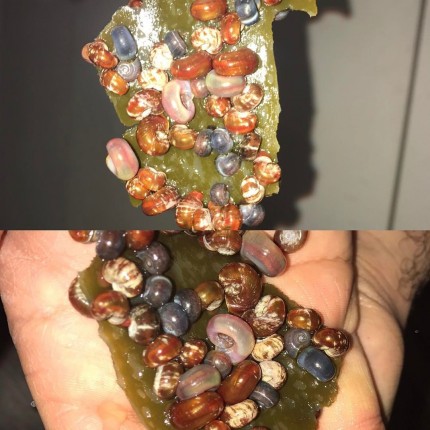Shrimp socialization - crossbreeding table
Shrimp with shrimp
 Different colorings of the genus Neocaridina have mostly wild colored offspring. In the following generations colored animals appear again and again, but the majority is brownish-transparent and relatively unspectacular. Even here there are a few exceptions, for example Blue Jelly, Blue Rili, Red Rili and Red Fire or Sakura can be kept together without wild colored offspring, because these colors are closely related.
Different colorings of the genus Neocaridina have mostly wild colored offspring. In the following generations colored animals appear again and again, but the majority is brownish-transparent and relatively unspectacular. Even here there are a few exceptions, for example Blue Jelly, Blue Rili, Red Rili and Red Fire or Sakura can be kept together without wild colored offspring, because these colors are closely related.
Red and black bee shrimp groups will have a majority of red and black shrimp, but over time animals with more brownish undertones will accumulate.
Bee, Shadow/Taiwan and Tiger shrimp also mix, as do all other shrimp (e.g. Tangerine Tiger or Aura Blue) from the Caridina serrata group. Here, however, crossbreeding is often done on purpose, because the hybrids, the so-called tiger bees, tibees or taitibees, look very attractive and many new color strokes and patterns are created in their offspring.
Dwarf shrimp that are not closely related can be put together without risk of crossbreeding, but this says nothing about the requirements of the animals! Different shrimps may need very different water values, so you should never just mix them. In case of doubt, a species tank is generally preferable.
Fan shrimp can be socialized well with each other, and also with dwarf shrimp the coexistence works without problems.
Large-armed shrimp, on the other hand, are not well compatible - dwarf shrimp like to be seen as a snack, and even similarly sized fan shrimp become prey at the latest during the next molt. So they should not be socialized with other shrimp.
Before putting two different shrimp strains together, a quarantine is recommended, so that the animals can get used to the different bacteria. To do this, place the animals separately and exchange about 250 ml of water between the aquariums every day for two weeks.
Shrimp with fish
 Dwarf shrimp should not be socialized with large, potentially predatory fish, as they fit perfectly into their prey pattern. Basically, what fits in the mouth gets eaten. Some fish go even further and add: ... and what doesn't fit will be made to fit.
Dwarf shrimp should not be socialized with large, potentially predatory fish, as they fit perfectly into their prey pattern. Basically, what fits in the mouth gets eaten. Some fish go even further and add: ... and what doesn't fit will be made to fit.
Even with the so-called nano fish, at least the tiny shrimp offspring is potentially endangered. Herbivores such as antenna catfish are safe - provided the aquarium size fits.
Fan shrimp should not be kept with curious fish such as guppies. Even if they are not eaten due to their size, they are still disturbed strongly and then retreat.
Large-armed shrimp are eaten by large fish and in turn chase smaller fish.
Shrimps with crayfish
 Dwarf crayfish sometimes view dwarf shrimp as food. Dwarf shrimp can be socialized with large crayfish with relative ease.
Dwarf crayfish sometimes view dwarf shrimp as food. Dwarf shrimp can be socialized with large crayfish with relative ease.
Fan shrimp like to be seen as prey and are attacked after molting at the latest.
Large arm shrimp do not get along with crayfish, usually the crayfish are overwhelmed and eaten after molting at the latest.
Shrimps with snails
 Dwarf and fan shrimp can be easily socialized with most snail species. Fan shrimp are even ideal aquarium companions with filter feeding snails, for example of the genera Brotia or Taia, because they also need a lot of fine food. Predatory snails have occasionally been observed preying on live shrimp.
Dwarf and fan shrimp can be easily socialized with most snail species. Fan shrimp are even ideal aquarium companions with filter feeding snails, for example of the genera Brotia or Taia, because they also need a lot of fine food. Predatory snails have occasionally been observed preying on live shrimp.
Large-armed shrimp consider snails as food and will crack even hard shells.
Note on the crossbreeding table: Red crosses mean: Shrimp interbreed, do not put together (unless interbreeding is desired), gray circles mean: Shrimps do not interbreed (please still consider different requirements)

Pictures : Chris Lukhaup / Crustahunter



Sehr Informativ
Danke für diese Info. Es hat mir wieder gezeigt das ich ab und zu doch Recht hatte mit dem was ich weiter gegeben habe an Freunde. Und konnte mein Wissen wieder etwas erweitern damit .
Nicht ganz schlüssig
Ihr Lieben, Eure Infos über die verschiedenen Kreuzungsmöglichkeiten find ich super. Der Kreuszungstabelle fehlt allerdings eine Legende. Spontan würde ich rote Kreuze als "geht nicht" interpretieren, die grauen Kringel als "kann man verpaaren", die Striche ...? Allerdings schreibt ihr oben im Text, dass man Tiger und Bienen absichtlich vermischt, weil dabei besonders interessante Tierchen herauskommen. In der Tabelle haben die allerdings ein rotes Kreuz. Könnt Ihr dazu vielleicht doch noch 1-2 Erklärungen schreiben?! Vielen Dank!
Liebe Grüße, Sylvia
Sehr wohl schlüssig ;)
Hi,
Auch wenn ich meiner Vorrednerin grundsätzlich recht gebe das eine Legende sinnvoll ist, ist sie in diesem Falle irgendwie unnötig, da man sehr schnell mit logischem denken dahinter kommt was was bedeuted.
Ein Strich steht grundsätzlich nur bei der selben... ähm Ganele ^^ also bei Amano und Amano. Warum? Nun klar da man die nicht kreuzen braucht/kann da dies der normale gang der dinge ist und keine Kreuzung sondern Vermehrung/Zucht ist. ^^
Ein x hab ich auch erst für geht nicht gehalten, nur da Yollow Fire, Red Fire, Sakura und co alles Garnelen der selben Gattung sind und man dies auch bei den unterschiedlichen Bienegarnelen sieht heißt x wohl kreuzung möglich.
Da man Amanos mit nichts kreuzen kann und diese auch überall außer sich selbst einen kreis haben wird der also nicht möglich heißen.
Ergo Legende unnötig, kurzes innehalten und drüber nachdenken und klack versteht mans auch ohne Legende und ich hab sicherlich keinen überdurchschnittlichen IQ :)
LG
Erklärung
ich denke eher, ROTES KREUTZ ---> Paarung möglich!
weil ich glaube nicht, das sich Monsterfächer mit Red Bee kreuzt ;) ---> 0
einige Arten fehlen
einige Arten wie die Blue Bee fehlen
Züchtersicht
Die Tabelle ist sicher aus Züchtersicht geschrieben. Man will ja quasi reinrassigen Nachwuchs züchten.
Ein rotes x zeigt also: Diese Arten, z. B. Red Fire und White Pearl, soll man _nicht_ zusammen halten, denn das gibt unerwünschte Mischformen!
Kombinationen mit schwarzem Kreis, z. B. Red Fire und Grüne Garnelen, kann man bei gleichen Ansprüchen an die Umgebung zusammen halten, weil die sich eben nicht kreuzen und man die einzelnen Färbungen damit nicht gefährdet.
Hm..
Hallo,
Also dem kann ich nicht ganz zustimmen.
Bei Garnelio habe ich blaue tigergarnelen
Red sakura und grüne bestellt.
Nun reicht mein repertoire von gelb über rot getigert bis hin zu einem sanften baby blau.
Nicht falsch verstehen alle samt wunderschön und putz munter.
Aber mit der Tabelle nicht zu vereinbaren.
Kreuzung
Was ist die Black Carbon Rili Garnele für eine Art und mit wem vergleichbar auf die Kreuzung bezogen ? Danke Uwe
Nicht schlecht
Es fehlen doch einige Arten. Und das macht die Tabelle manchmal untauglich. Schade. Im Großen und Ganzen aber informativ.
Danke!
Die Informationen sind sehr gut zu lesen. Mein Wissen wird bei jedem Kauf erweitert. Es ist alles verständlich, und trägt zu einem schöneren Aquarium bei. Danke.